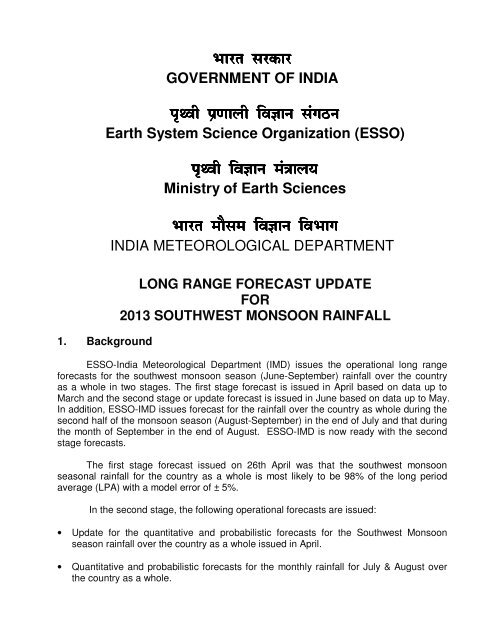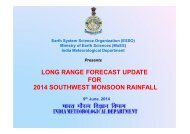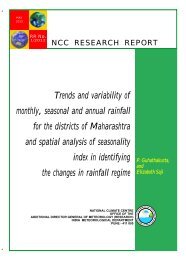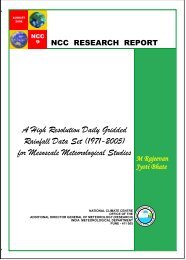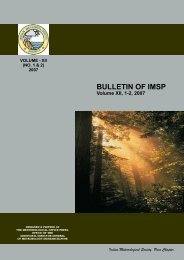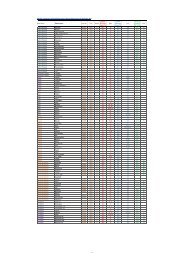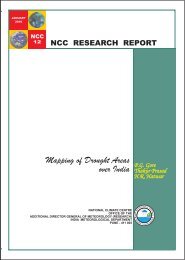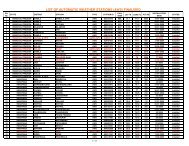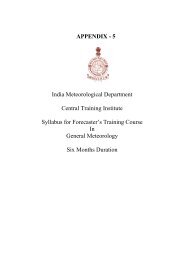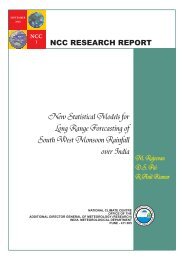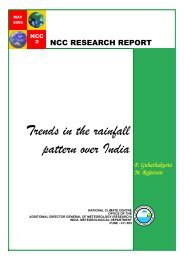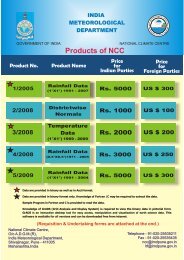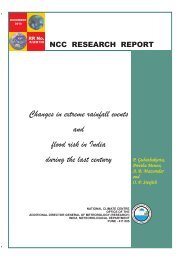LRF SW Monsoon Second Stage Forecast 2013 - (IMD), Pune
LRF SW Monsoon Second Stage Forecast 2013 - (IMD), Pune
LRF SW Monsoon Second Stage Forecast 2013 - (IMD), Pune
- No tags were found...
Create successful ePaper yourself
Turn your PDF publications into a flip-book with our unique Google optimized e-Paper software.
1. BackgroundBaarta sarkarGOVERNMENT OF INDIApaRTvaI pa/NaalaI iva&aana saMgaQnaEarth System Science Organization (ESSO)paRTvaI iva&aana maM…aalayaMinistry of Earth SciencesBaarta maaOsama iva&aana ivaBaagaINDIA METEOROLOGICAL DEPARTMENTLONG RANGE FORECAST UPDATEFOR<strong>2013</strong> SOUTHWEST MONSOON RAINFALLESSO-India Meteorological Department (<strong>IMD</strong>) issues the operational long rangeforecasts for the southwest monsoon season (June-September) rainfall over the countryas a whole in two stages. The first stage forecast is issued in April based on data up toMarch and the second stage or update forecast is issued in June based on data up to May.In addition, ESSO-<strong>IMD</strong> issues forecast for the rainfall over the country as whole during thesecond half of the monsoon season (August-September) in the end of July and that duringthe month of September in the end of August. ESSO-<strong>IMD</strong> is now ready with the secondstage forecasts.The first stage forecast issued on 26th April was that the southwest monsoonseasonal rainfall for the country as a whole is most likely to be 98% of the long periodaverage (LPA) with a model error of ± 5%.In the second stage, the following operational forecasts are issued:• Update for the quantitative and probabilistic forecasts for the Southwest <strong>Monsoon</strong>season rainfall over the country as a whole issued in April.• Quantitative and probabilistic forecasts for the monthly rainfall for July & August overthe country as a whole.
• Quantitative and probabilistic forecasts for the season rainfall for the 4 broadgeographical regions of India (NW India, NE India, Central India and South Peninsula).The list of states included in each of these four geographical regions is given below.Northwest India:– Jammu and Kashmir, Himachal Pradesh, Punjab, Rajasthan, Haryana,Chandigarh, Delhi, Uttaranchal and Uttar Pradesh.Northeast India:– Arunachal Pradesh, Meghalaya, Assam, Nagaland, Manipur, Mizoram,Tripura, Sikkim, West Bengal, Bihar and Jharkhand.Central India: – Gujarat State, Madhya Pradesh, Chattisgarh, Maharashtra, Goa andOrissa.South Peninsula:– Andhra Pradesh, Karnataka, Tamil Nadu, Kerala, Lakshadweep andAndaman and Nicobar Islands.The long period average (LPA) and coefficient of variation of monthly and seasonrainfall over various regions based on the 1951-2000 data are given below:Region LPA (mm)Coefficient ofVariation (%)Season (June to September) RainfallAll India 887.5 10.7Northwest India 615.0 18.9Central India 975.5 15.0Northeast India 1438.3 12.6South Peninsula 715.5 15.3Monthly RainfallAll India (July) 289.2 12.7All India (August) 261.3 14.22. The Present Operational Long Range <strong>Forecast</strong>ing System2.1. 6-Parameter Ensemble <strong>Forecast</strong>ing System for the Seasonal (June– September) Rainfall over the Country as a wholeThe update forecast for the southwest monsoon season (June-September) rainfallover the country as a whole is issued using a 6-parameter Ensemble <strong>Forecast</strong>ing System.The 6 predictors used are: North Atlantic Sea Surface Temperature (December + January),Southeast equatorial Indian Ocean Sea Surface Temperature (February + March), EastAsia Mean Sea Level Pressure (February + March), Central Pacific (Nino 3.4) Sea Surface2
Temperature Tendency (March to May - December to February), North Atlantic Mean SeaLevel Pressure (May) and North Central Pacific Zonal Wind at 850hPa (May).The 6-parameter ensemble statistical forecasting system was also used to prepareprobability forecasts for five pre-defined rainfall categories.2.2. <strong>Forecast</strong>ing System for the Monthly Rainfall over the Country as aWholeFor the quantitative forecasts of monthly rainfall (for the months of July & August)over the country as a whole, separate principal component regression models were used.The models for each month were based on separate set of predictors. The model error ofeach of these two PCR models is ± 9%. The same models were also used for generatingprobability forecast for the pre-defined 3 (tercile) categories of monthly rainfall.The 6 predictors used for July model are: East Asia mean sea level pressure(February), North Atlantic sea surface temperature (December of previous year), NorthAmerica mean sea level pressure (January), North Atlantic mean sea level pressuregradient (March), North central Pacific zonal wind at 850hPa (May) and NINO 3.4 seasurface temperature tendency (MAM-DJF).The 5 predictors used for the August model are: South Atlantic mean sea levelpressure (April), Southeast Pacific sea surface temperature (May), NINO 3.4 sea surfacetemperature tendency (MAM-DJF)), South Pacific zonal wind at 850hPa (April), andoutgoing long wave radiation over tropical north Atlantic (May).2.3. <strong>Forecast</strong>ing System for the Seasonal Rainfall over the 4 broadgeographical regions of the countryFor the quantitative forecasts of rainfall during the southwest monsoon season(June to September) over the 4 broad geographical regions, separate principal componentregression models were used. The models for each region were based on separate set ofpredictors. All the four PCR models have average model errors of ± 8% of LPA. The samemodels were also used for generating probability forecast for the pre-defined 3 (tercile)categories of seasonal rainfall.The 5 parameters used in the model for NW India are; North Atlantic surface meansea level pressure gradient (May), South Atlantic surface mean sea level pressure(January), East Asia surface mean sea level pressure (February + March), North CentralPacific Zonal Wind at 850hPa (May) and NINO 3.4 sea surface temperature tendency(MAM-DJF).The 6 parameters used in the model for Central India are; North Atlantic seasurface temperature (December +January), North Atlantic surface mean sea levelpressure gradient (May), East Asia surface mean sea level pressure (March), EquatorialEast Indian Ocean sea surface temperature (Feb), NINO 3.4 sea surface temperaturetendency (MAM-DJF) and North Central Pacific U850 (May).3
The 6 parameters used in the model for South Peninsula are; Southeast IndianOcean mean sea level pressure (May), Southeast equatorial Indian Ocean sea surfacetemperature (October of previous year), Northwest Europe land surface air temperature(January), Southeast Pacific surface mean sea level pressure (May), Northwest Pacificzonal wind at 850hpa (February) and NINO 3.4 sea surface temperature tendency (MAM-DJF).The 5 Parameters used in the model for the North-East India are: South Atlanticmean sea level pressure (January), North Atlantic mean sea level pressure (April), centralPacific sea surface temperature (May), warm water volume (Feb + Mar) and North Atlanticmean sea level pressure (March).3. Experimental Dynamical <strong>Forecast</strong> System3.1. <strong>Monsoon</strong> Mission Experimental Coupled Dynamical Model<strong>Forecast</strong>ing SystemThe <strong>Monsoon</strong> Mission was recently launched by the ESSO with an objective toimprove the monsoon forecasts over the country in short range to long range time scales.The ESSO-Indian Institute of Tropical Meteorology (IITM), <strong>Pune</strong> is coordinating andworking along with different climate research centers from India and abroad on thedevelopment of a coupled model for the forecasting Indian summer monsoon rainfall. Forthis purpose, the state-of-the-art coupled climate model, the Coupled <strong>Forecast</strong>ing System(CFS) developed by the National Centers for Environmental Prediction (NCEP), USA hasbeen implemented at the ESSO-IITM. The latest high resolution research version of thecoupled model (CFS Version 2) has been used to generate the experimental updateforecast for the <strong>2013</strong> <strong>SW</strong> <strong>Monsoon</strong> season rainfall using the April initial conditions. Themodel has moderate skill.The experimental forecast based on the monsoon mission dynamical predictionsystem using the April initial conditions indicates that the rainfall during the <strong>2013</strong> monsoonseason (June to September) averaged over the country as a whole is likely to be 108% ±4% of long period model average (LPMA).3.2. <strong>IMD</strong> Seasonal <strong>Forecast</strong> Model (SFM)Since 2004, <strong>IMD</strong> has been generating experimental dynamical forecast for thesouthwest monsoon rainfall using the seasonal forecast model (SFM) of the ExperimentalClimate Prediction Center (ECPC), USA. The global sea surface temperature (SST)forecasts from NCEP coupled forecasting system (CFS) version 2 model was used asboundary forcing for the SFM model. The model showed moderate skill. For generatingthe forecasts, ten ensemble member forecasts were obtained using the initial conditionscorresponding to 00Z from 1 st to 10 th of May.The experimental forecast based on the <strong>IMD</strong>-SFM using the May initial conditionsindicates that the rainfall during the <strong>2013</strong> monsoon season (June to September) averagedover the country as a whole is likely to be 98% ± 4% of long period model average (LPMA).4
4. Experimental <strong>Forecast</strong>s from National and InternationalInstitutionsThe experimental forecasts prepared by various national institutes like the SpaceApplications Centre, Ahmedabad, Centre for Mathematical Modeling and ComputerSimulation, Bangalore, Center for Development of Advanced Computing, <strong>Pune</strong> and theIndian Institute of Tropical Meteorology, <strong>Pune</strong> were available. Operational/experimentalforecasts prepared by international institutes like the National Centers for EnvironmentalPrediction, USA, International Research Institute for Climate and Society, USA,Meteorological Office, UK, Meteo France, the European Center for Medium RangeWeather <strong>Forecast</strong>s, UK, Japan Meteorological Agency, Japan Agency for Marine-EarthScience and Technology, Asian-Pacific Economic Cooperation (APEC) Climate Centre,Korea and World Meteorological Organization’s Lead Centre for Long Range <strong>Forecast</strong>ing -Multi-Model Ensemble were also available.The forecasts for seasonal rainfall over the country from various centers showedlarge divergence in terms of both total quantity and spatial distribution.5. <strong>Monsoon</strong> So FarThis year, setting in of southwest monsoon over the Andaman Sea was advancedby 3 days. The monsoon was set in over Kerala on 1st June which is also the normal dateof onset. On 1st June, it also advanced into entire south Arabian Sea, Maldive-Comorinarea, Lakshadweep, some parts of central Arabian Sea, entire Kerala, some parts ofCoastal & South Interior Karnataka, and most parts of Tamilnadu. It covered restKarnataka, entire Arunachal Pradesh & Goa, most parts of Andhra Pradesh, Assam,Meghalaya, Nagaland, Manipur, Mizoram, southern parts of Maharashtra and some partsof West Bengal & Sikkim by 8th June <strong>2013</strong>. It further advanced over South Gujarat &Madhya Pradesh, many parts of Chhattisgarh, entire Orissa and some parts of Jharkhandand some more parts of West Bengal on 10 th June, <strong>2013</strong>.As on 14 th June, <strong>2013</strong>, The Northern Limit of <strong>Monsoon</strong> (NLM) passes through Lat.25.0°N / Long. 60.0°E, Lat. 25.0° N/ Long. 65.0°E, Udaipur, Guna, Satna, Ranchi,Berhampore, Jalpaiguri and Gangtok.The cumulated seasonal rainfall over the country as a whole during the period1-13 th June is given below.Cumulative RainfallRegions(1-13 th June)(% of LPA)Country as a whole 128Northwest India 150Central India 209South Peninsula 159North East India 535
6. Sea Surface Temperature (SST) Conditions in the EquatorialPacific & Indian OceansThe borderline El Niño SST conditions that prevailed over the equatorial Pacific for abrief period between July and September 2012 weakened and the ENSO-neutralconditions returned during October, 2012. Since then, ENSO-neutral conditions havecontinued through early part of June, <strong>2013</strong>. The latest forecasts from a majority of thedynamical and statistical models indicate that ENSO neutral conditions are most likely (witha probability of about 65%) to continue during the monsoon season. The probability of theemergence of weak La Nina conditions during later part of the monsoon season hasincreased to its climatological value. However, probability of the emergence of El Ninoconditions during the monsoon season is very less.In addition to the ENSO conditions over Pacific, other factors such as the IndianOcean Sea surface temperatures (SSTs) have also some influence on Indian monsoon.Recent forecasts from some coupled models suggest possibility of the development of aweak negative Indian Ocean Dipole event during the northern hemisphere (NH) summerand to have a peak magnitude during the NH autumn. As the sea surface temperatureconditions over the Pacific and Indian Oceans particularly ENSO conditions over the Pacific(El Nino or La Nina) are known to have strong influence on the Indian summer monsoon,<strong>IMD</strong> is carefully monitoring the evolution of conditions over the Pacific and Indian oceans.7. <strong>Forecast</strong>s for <strong>2013</strong> Southwest <strong>Monsoon</strong> Rainfalli) Southwest <strong>Monsoon</strong> Season Rainfall over the country as a wholeQuantitatively, monsoon season rainfall for the country as a whole is likely to be98% of the long period average (LPA) with a model error of ±4%. The LPA rainfall over thecountry as a whole for the period 1951-2000 is 89 cm.The 5 category probability forecasts for the Season (June to September) rainfallover the country as a whole is given below. Accordingly Rainfall over the country as awhole for the <strong>2013</strong> southwest monsoon season is most likely to be normal (96-104% ofLPA).CategoryRainfall Range <strong>Forecast</strong> Climatological(% of LPA) Probability (%) Probability (%)Deficient < 90 9 16Below Normal 90 - 96 28 17Normal 96 -104 47 33Above Normal 104 -110 14 16Excess > 110 2 176
ii)Monthly (July & August) Rainfall over the country as a wholeRainfall over the country as a whole for the month of July <strong>2013</strong> is likely to be 101%of its LPA and that for the month of August is likely to be 96% of LPA both with a modelerror of ± 9 %.The 3 category probability forecasts for the monthly (July & August) Rainfall overthe country as a whole are given below. All the 3 rainfall categories have equalclimatological probabilities (33.33% each).JulyAugustRainfallCategoryRange <strong>Forecast</strong> Range <strong>Forecast</strong>(% of LPA) Probability (%) (% of LPA) Probability (%)Below Normal 106 21iii)Season Rainfall over Broad Geographical RegionsOver the four broad geographical regions of the country, rainfall for the <strong>2013</strong> <strong>SW</strong><strong>Monsoon</strong> Season is likely to be 94% of its LPA over North-West India, 98% of its LPA overCentral India, 103% of its LPA over South Peninsula, and 98% of its LPA over North-EastIndia all with a model error of ±8 %. The 3 category probability forecasts for seasonalrainfall over the four broad geographical regions are given below. All the 3 rainfallcategories have equal climatological probabilities (33.33% each).RainfallCategoryRange(% ofLPA)NW India Central India South Peninsula Northeast India<strong>Forecast</strong>Probability(%)Range(% ofLPA)<strong>Forecast</strong>Probability(%)Range(% ofLPA)<strong>Forecast</strong>Probability(%)Range(% ofLPA)<strong>Forecast</strong>Probability(%)Below Normal 105 25New DelhiThe 14 th June <strong>2013</strong>24 th Jyaistha 1935 (SE)L. S. RathoreDirector General of Meteorology7


